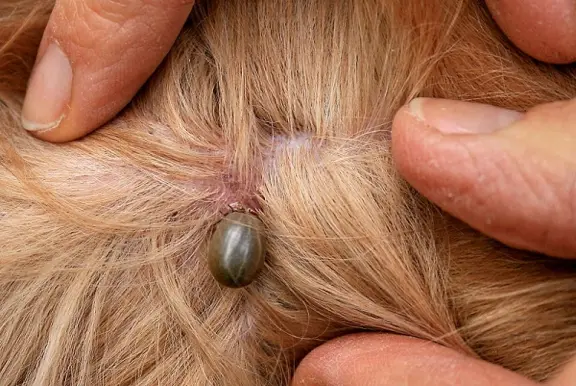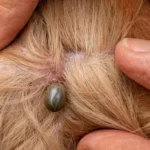Ticks are pesky parasites that can be a real nuisance for our beloved furry friends. As responsible dog owners, it’s essential to understand the importance of removing ticks from our dogs and the potential risks these tiny creatures pose to our pets’ health and well-being. In this comprehensive guide, we will explore everything you need to know about dog ticks and how to effectively remove them to keep your canine companion happy and healthy.


Understanding Dog Ticks
Before we delve into the methods of tick removal, let’s take a closer look at these tiny troublemakers. There are several types of ticks that can affect dogs, including the common American dog tick, brown dog tick, and the dreaded deer tick (also known as the black-legged tick). Each species varies in size and appearance, but they all have one thing in common: their thirst for blood.
Ticks have a fascinating life cycle, consisting of four stages: egg, larva, nymph, and adult. They rely on hosts, like our dogs, to feed on during each of these stages. Once a tick finds its way onto your dog, it attaches itself by burrowing its mouthparts into the skin, making it challenging to dislodge.
These bloodsuckers can be found all over a dog’s body, but they tend to favor warm and moist areas such as the ears, head, neck, and underbelly. Checking these areas regularly for ticks is crucial to catch and remove them promptly.
Ticks can be a persistent problem for our furry friends, but there are several effective and natural home remedies that can help repel and remove these pesky parasites from your dog’s life. In this section, we will explore some safe and DIY methods to keep your canine companion tick-free.
Home Remedies for Dog Ticks
A. Natural Tick Repellents
- Apple Cider Vinegar: Dilute apple cider vinegar with water and use it as a spray on your dog’s coat. The strong scent repels ticks and other pests.
- Neem Oil: Neem oil is a powerful natural insect repellent. Mix a few drops of neem oil with a carrier oil like coconut oil and apply it to your dog’s skin.
- Lemon Spray: Lemon contains citric acid, which is effective against ticks. Mix freshly squeezed lemon juice with water and spray it on your dog’s fur.
- Rosemary: Boil fresh rosemary in water, let it cool, and use it as a rinse after bathing your dog. Rosemary has natural tick-repellent properties.
B. DIY Tick Repellent Sprays
- Vinegar and Water Spray: Mix equal parts of water and white vinegar in a spray bottle. Spray this solution on your dog’s coat before heading outside.
- Essential Oil Spray: Create a tick repellent spray using essential oils. Mix a few drops of lavender, eucalyptus, peppermint, or cedarwood oil with water in a spray bottle and apply it to your dog’s fur.
- Alcohol Spray: Mix rubbing alcohol with water and spray it on your dog’s coat. The alcohol will help deter ticks.
C. Safe Herbs and Essential Oils
- Lavender Oil: Lavender oil has a pleasant aroma and acts as a natural tick repellent. It’s safe for dogs and can soothe their skin.
- Eucalyptus Oil: Eucalyptus oil is another effective tick repellent. Ensure to dilute it properly before applying it to your dog’s coat.
- Cedarwood Oil: Cedarwood oil has natural insect-repelling properties and is safe for dogs. Mix it with water or a carrier oil and spray it on your dog’s fur.
- Rose Geranium Oil: This essential oil not only repels ticks but also fleas and mosquitoes. Dilute it with water and apply it to your dog’s coat.
How to Avoid/Prevent and Control Ticks in Dogs
Ticks can be troublesome pests that pose health risks to our furry friends. Taking proactive measures to avoid, prevent, and control tick infestations is essential to ensure your dog’s well-being. Here are some valuable tips to help you keep your dog safe from ticks:
A. Preventing Tick Infestations in Dogs
Prevention is key when it comes to tick infestations in dogs. Here are some effective tips to keep ticks at bay:
1. Tick Preventive Medications: Consult your veterinarian about tick preventive medications suitable for your dog’s specific needs. These medications come in various forms, such as topical treatments, oral tablets, or collars, and they can help repel ticks and prevent infestations.
2. Regular Tick Checks: After outdoor activities, thoroughly inspect your dog’s entire body for ticks. Pay close attention to areas like the ears, armpits, groin, and between the toes, as ticks prefer warm and moist areas.
3. Tick Collars: Consider using tick collars that release tick-repelling chemicals to provide continuous protection for your dog. Make sure to choose a collar that fits comfortably and is safe for your dog’s breed and size.
4. Avoid Tick-Infested Areas: When possible, avoid areas with tall grass, dense vegetation, or wooded regions where ticks are commonly found. Stick to well-maintained paths and open areas during walks.
5. Clean and Groom Your Dog: Regular grooming not only helps keep your dog’s coat healthy but also allows you to spot ticks early and remove them promptly.
B. Measures for Tick Control in the Dog’s Environment
Taking steps to control ticks in your dog’s environment can significantly reduce the risk of infestations. Here are some effective measures:
1. Maintain a Clean Yard: Keep your yard well-maintained by regularly mowing the grass and removing any debris or leaf piles where ticks might hide.
2. Use Tick Control Products: Consider using tick control products designed for your yard, such as tick sprays or granules. These products can help create a tick-free environment for your dog.
3. Frequent Yard Inspections: Regularly inspect your yard for any signs of ticks and address any infestations promptly. Pay attention to areas where your dog spends time the most.
4. Reduce Wildlife Visitors: Ticks can hitch a ride on wildlife like deer or rodents. Take measures to reduce wildlife visitors in your yard, such as installing fences or motion-activated deterrents.
5. Create Tick-Free Zones: Designate specific areas in your yard where your dog spends time most often, and take extra precautions to keep these areas tick-free.
C. Importance of Regular Grooming and Tick Checks
1. Bathe Your Dog Regularly: Regular baths with dog-friendly tick shampoos can help repel ticks and keep your dog’s coat clean. Consult your veterinarian for the best products suitable for your dog’s skin and coat.
2. Thorough Tick Checks: Make it a habit to check your dog for ticks after outdoor activities, walks, or hikes. Prompt tick removal is crucial to prevent the transmission of tick-borne diseases.
Taking proactive measures to avoid, prevent, and control ticks in dogs not only protects your beloved pet but also contributes to a happy and healthy life. By staying vigilant and following these tips, you can minimize the risk of tick-related health issues and enjoy quality time with your four-legged companion.
What Kills Ticks on Dogs Instantly
Ticks can be a nuisance and a health risk for our beloved canine companions. As responsible dog owners, it’s crucial to know how to protect our furry friends from these pesky parasites. In this article, we’ll explore the different methods and products that can effectively kill ticks on dogs instantly, ensuring their well-being and preventing tick-borne diseases.
Fast-Acting Tick-Killing Products and Medications
When it comes to getting rid of ticks quickly, there are several products and medications available on the market. One of the most common and effective options is tick shampoos and sprays. These products contain active ingredients that work to kill ticks on contact. When applied properly, they can provide immediate relief to your dog and eliminate ticks from their coat.
Another fast-acting option is tick collars. These collars are infused with tick-killing chemicals that spread throughout your dog’s body, targeting and eliminating ticks they come into contact with. They are easy to use and can provide protection for several months.
Another great option is Rubbing Alcohol, nothing kills is the ticks as fast as pure rubbing alcohol.
The Efficacy and Safety of Topical Tick Treatments
Topical tick treatments are applied directly to your dog’s skin, usually between their shoulder blades. These treatments contain powerful ingredients that kill ticks quickly upon contact. They are long-lasting and can provide protection for up to a month. However, it’s essential to choose a reputable brand and consult your veterinarian before using any topical tick treatment to ensure its efficacy and safety for your specific dog breed.
Oral Medications for Quick Tick Elimination
Oral tick medications are becoming increasingly popular due to their convenience and effectiveness. These medications come in the form of chewable tablets or soft chews that your dog can easily consume. Once ingested, the active ingredients enter your dog’s bloodstream and kill ticks when they bite. Oral medications are known for their rapid action, and they can start working within hours. However, like any medication, it’s essential to follow your veterinarian’s advice and dosing instructions to ensure your dog’s safety.
How to Remove Ticks from Dogs’ Ears
Ticks can sometimes find their way into your dog’s ears, causing discomfort and potential health issues. Removing ticks from this sensitive area requires gentle and careful handling.
Step-by-Step Guide for Safe Tick Removal
- Prepare: Gather the necessary tools, such as fine-tipped tweezers or tick removal tools, rubbing alcohol, and cotton balls.
- Stay Calm: Approach your dog calmly and reassure them with soothing words and gentle touches.
- Examine the Area: Use a flashlight to examine your dog’s ears carefully. Look for any ticks attached to the skin.
- Grasp the Tick: Using the tweezers or tick removal tool, grasp the tick as close to the skin’s surface as possible.
- Remove Gently: Steadily pull the tick upward with even pressure. Avoid twisting or squeezing the tick to prevent leaving any body parts behind.
- Disinfect the Area: After removal, clean the area with rubbing alcohol and a cotton ball to prevent infection.
Specialized Tools for Tick Removal
Several specialized tick removal tools are available in the market, such as tick hooks and tick spoons. These tools are designed to safely and effectively remove ticks without causing harm to your dog’s skin.
The Importance of Proper Tick Removal
Proper tick removal is crucial to prevent infection and reduce the risk of tick-borne diseases. When removing ticks from your dog’s ears or any other part of their body, it’s essential to be gentle and patient. Mishandling ticks can lead to their mouthparts getting stuck in your dog’s skin, increasing the risk of infection. If you are unsure or uncomfortable with tick removal, it’s best to seek assistance from your veterinarian.
With the right knowledge and tools, you can protect your furry companion from ticks and ensure they lead a healthy and happy life free from these pesky parasites. Remember, prevention is key, so consider using tick preventive measures recommended by your veterinarian to keep your dog safe from ticks all year round.
Precautions and Aftercare
Ticks can be a pesky problem for our canine companions, but knowing how to safely remove them is essential for their well-being. In this guide, we’ll cover the proper steps to remove ticks from dogs and the precautions and aftercare measures you need to take to ensure a safe and successful tick removal process.
Precautions During Tick Removal
When removing ticks from your dog, it’s crucial to take certain precautions to prevent the tick from regurgitating harmful pathogens into your dog’s bloodstream. This can happen if you squeeze or crush the tick while removing it. To avoid this, use fine-tipped tweezers or specialized tick removal tools, and grasp the tick as close to the skin’s surface as possible. Apply gentle, steady pressure and pull the tick upward in a slow, smooth motion. Avoid twisting or jerking the tick to minimize the risk of its mouthparts breaking off and remaining in your dog’s skin.
Proper Disposal of Removed Ticks
After successfully removing the tick, proper disposal is essential to prevent any potential reinfestation or harm to other pets or humans. Place the tick in a sealed container or a plastic bag. If you suspect the tick was carrying any diseases, you can save it for identification by a veterinarian. You can also dispose of the tick by flushing it down the toilet or drowning it in rubbing alcohol. Do not crush the tick with your fingers or dispose of it in open trash bins.
Aftercare and Monitoring
After tick removal, it’s essential to provide aftercare to your dog. Clean the bite area with mild soap and water or an antiseptic solution. Keep an eye on the area for any signs of infection, such as redness, swelling, or discharge. If you notice any unusual symptoms, consult your veterinarian promptly.
Additionally, monitor your dog for any signs of tick-borne diseases. Common symptoms include lethargy, loss of appetite, fever, and joint pain. If you observe any of these signs, seek veterinary attention immediately. Early detection and treatment of tick-borne illnesses are crucial for your dog’s well-being.
When to Seek Veterinary Help
While most tick removals can be done at home, there are situations where professional veterinary assistance is necessary. If you are uncomfortable or unsure about removing a tick, or if the tick is deeply embedded, it’s best to consult your veterinarian.
Furthermore, certain symptoms after a tick bite may indicate the presence of a tick-borne disease. These include prolonged lethargy, lameness, difficulty breathing, or changes in behavior. If your dog exhibits any of these symptoms, it’s essential to seek immediate veterinary care.
Conclusion
Proper tick removal is vital for your dog’s health and well-being. By following the precautions and aftercare measures outlined in this guide, you can safely remove ticks from your dog and reduce the risk of tick-borne diseases.
Remember to implement preventive measures to protect your dog from ticks, such as using tick preventatives recommended by your veterinarian and performing regular tick checks. Early detection and proper tick removal are key to ensuring your furry friend leads a happy and healthy life, free from the nuisance of ticks.
FAQs About Dog Tick Removal
What kills ticks on dogs immediately?
Rubbing Alcohol kills ticks on dogs. Nothing does the job quite like rubbing alcohol. Not only is it famous for killing any bad bacteria in wounds, but it can also wipe out a tick for good. After you remove the tick, drop it in a cup of alcohol and place a lid over it so it can’t escape.
How do you remove a tick from a dog yourself?
To remove a tick from a dog, use fine-tipped tweezers or a specialized tick removal tool. Grasp the tick as close to the skin’s surface as possible and pull it upward gently and steadily.
Can Dettol kill ticks on dogs?
Dettol is not recommended for tick removal on dogs. It’s best to use proper tick removal tools and methods to ensure safe and effective tick removal.
What will draw a tick out of a dog?
There are no proven methods to draw ticks out of a dog. Safe and effective tick removal involves using fine-tipped tweezers or tick removal tools to remove the tick.
Can lemon remove ticks from dogs?
Lemon is not a reliable method for tick removal on dogs. Stick to proper tick removal techniques using tweezers or tick removal tools.
Can hand sanitizer kill ticks on dogs?
Hand sanitizer is not an effective tick-killing method for dogs. Use approved tick-killing products and methods for safe removal.









